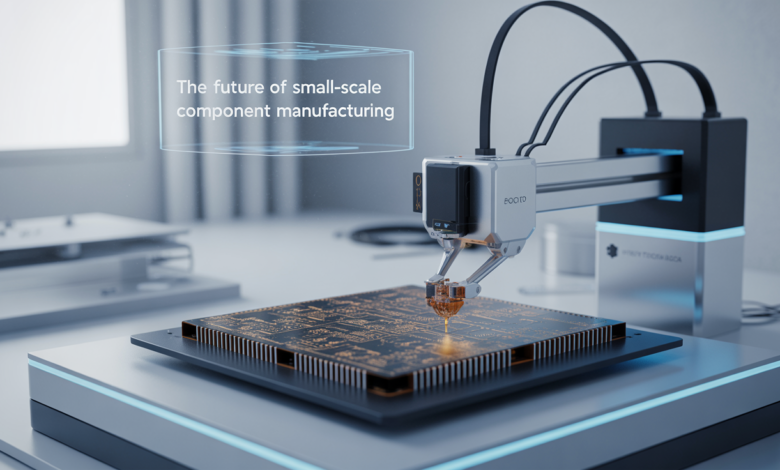The Future of Small-Scale Component Manufacturing

From gas cylinders in outdoor sport equipment, to life-saving devices such as the air water channel in endoscopy, this is an industry where advances in technology, automation, material science and global market factors are contributing to developing trends.
Minor features are now more than mere extras, they form the core of a product’s performance, safety and operability. With the high-performance demand on tools in an ever changing industry, Neo4 believes it would only be right to look into the future and develop some of the tools that will define the future of portable power.
Let’s take a look at the major trends and technologies shaping the future of the small components industry.
Automation and Smart Factories
The automation is the first most significant trend of this industry. Old school manual methods are being replaced by state-of-the-art robotics and smart production systems. In making minuscule things, steel BBs to miniature air water channels in medical scopes, precision is key.
Smart factories leverage real-time data, sensors and AI to track production lines in very fine detail. Not only does this eliminate room for error, it also makes the process more efficient, consistent, and fast.
Advantages of small part manufacturing by using automation:
- Reduced material waste
- Better quality and more stringent tolerance
- Faster lead times
- Greater ease of scale for production
Automation is key for manufacturers to keep ahead of demand for increasingly complex parts, especially where tiny flaws can lead to large functional failures, as with gas cylinders in pressurized systems or minimally invasive medical devices.
Advanced Materials and Alloys
Material science is another important factor affecting component manufacturing in the future. With increasing performance requirements, manufacturers are exploring novel alloys, composites and biocompatible materials with advanced strength, durability and environmental resistance.
In medical applications, the air water channel is for instance to be molded from materials that can survive multiple sterilization, resist corrosion as well as remain non-reactive in the human body.
Similarly, gas containers for outdoor sports are required to have airtightness for internal pressured resistance, rustproof performance, and fatigue-free lightweight body structure for carrying. In recent times, metallic coatings made of stainless steel, aluminum alloys and carbon composites are also used in these applications.
Material newbies to keep an eye on:
- Shape-memory alloys
- Nano-coatings
- Biodegradable polymers
- High-tensile carbon fiber
These materials are making possible new products that are lighter, stronger, more functional, and still exhibit micro-level precision.
Since that time, miniaturization and micromachining.
Miniaturization is both a threat and an opportunity to manufacturers, as companies work to produce smaller, more efficient products. This is particularly true in industries like medical devices, wearable electronics and drone technology in which every millimeter counts.
To address this demand, micromachining techniques such as laser machining, μ-EDM (electrical-discharge machining) and ultrasonic machining have become popular. These make possible extremely complex geometries to be incorporated into small components such as air water channel without degradation in strength.
With micromachining, we are able to fabricate parts with features smaller than 0.001 inches, allowing us to bring innovative solutions to all precision industries.
Additive Manufacturing 3D Printing
3D printing, or additive manufacturing (AM), which had been relegated to prototyping, is now capable of withstanding the challenge of low-volume production of high-precision small parts.
Especially beneficial for quick product development and customization, 3D printing can be used to produce intricate, lightweight geometries in way that is impossible using more traditional methods. It also compresses what would take weeks of the dev cycle to days.
For instance, sample gas tank prototypes can be printed and tested rapidly for pressure bearing and leakage resistance qualities. Likewise, complex constructs such as an air-water channel in endoscopes could be fabricated having inner pathways and smooth surfaces via selective laser sintering (SLS) or stereolithography (SLA).
In the long term, 3D printing is seen playing an increasingly greater role in short-run, on-demand production of specialized components, cutting the cost of maintaining stock of parts and allowing for local production.
AI and Vision Systems for Quality Assurance
When it comes to small part manufacturing, quality cannot be compromised. A defect on a microscale in a gas bottle can present a safety risk. Any pinhole in the air water channel could ruin an operation.
To combat this trend, manufacturers are incorporating AI-powered vision systems into quality control practices. These systems employ high-resolution cameras and algorithms to detect flaws that a human inspector might miss — scratches, voids, incorrect dimensions or assembly misalignments.
In the near future, these AI systems won’t just detect defects; they’ll also predict them on the basis of process variables, enabling real-time corrections and the achievement of zero-defect manufacturing.
Sustainable and eco-friendly policy items
With pressure mounting for industries around the world to minimise their carbon output, sustainability is impacting on the future of small-scale production.
Gas cylinders manufacturers are focusing on developing re-fillable and reusable gas cylinders to reduce environmental impact. Likewise, medical parts production, such as the air water channel, is being streamlined to minimize energy consumption and material consumption.
Businesses are also adopting environmentally friendly lubricants, water-based cleaning agents, and recyclable packaging for their produce. These measures can help projects conform to regulatory requirements as well as attract environmentally friendly consumers.
Supply chain Visibility and Localization
After the pandemic, the world’s manufacturing sector is far more alert to the risks of long, convoluted supply chains. One result is a turn toward localization and supply chain transparency.
Precision parts makers are now putting their money into digital supply chain products, blockchain for traceability, and localized production hubs to de-risk reliance on overseas suppliers and optimize lead times.
This is particularly pertinent for critical components such as gas cylinders or medical equipment, where any break can affect the safety or easy-of-use of the end-user.
Final Thoughts
The future of small part manufacturing is a smart, flexible leader. From outdoor sporting goods to medical instruments, the market’s need for high-performing miniaturized parts is high on the growth curve.
New technologies such as automated systems, advanced materials, microfabrication, and additive manufacturing are no longer optional—they are the building blocks of futureproof manufacturing. When companies adopt these innovations, they are enhancing product performance and also opening up new levels of efficiency, safety and customization.
Whether it’s the gas cylinders for tactical, as a precision air water channel in a medical device and the like, the future is small scale mastery, big picture thinking.




